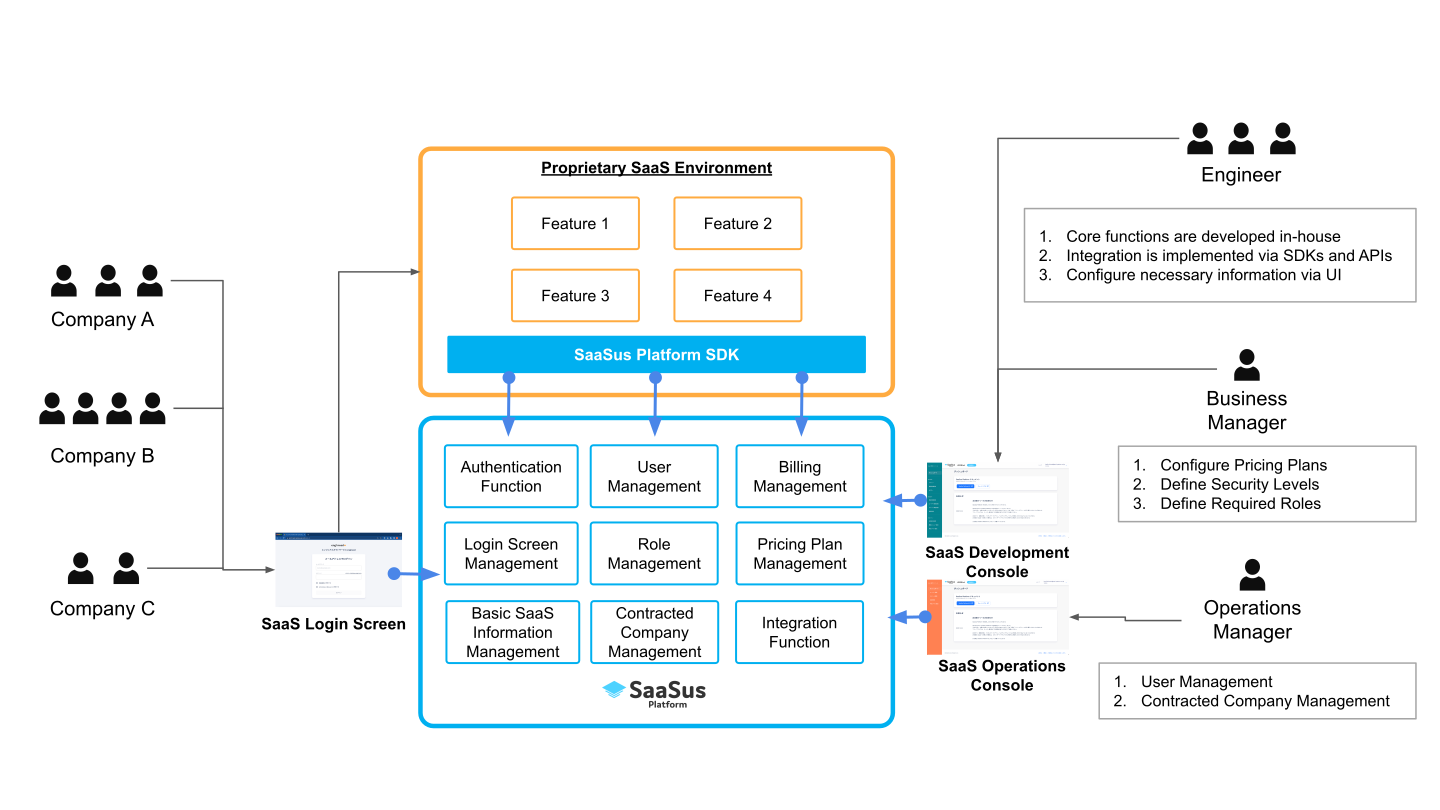SaaSus Platform Architecture
1. Role and Components of the Control Plane
Operating a SaaS application requires tenant management, user authentication & authorization, rate‑plan configuration, billing, and other complex shared capabilities. Building and maintaining these for every application incurs significant development effort and operational cost.
SaaSus Platform offers a control plane that centralizes these common features and provides SaaS‑specific best practices in a standardized form.
In this document, the consoles for configuring and operating a SaaS application—the “SaaS Development Console” and “SaaS Operation Console”—are collectively referred to as the ��“SaaSus Platform Console.”
Role
- Tenant‑scoped user management with role‑based access control
- Automated authorization and billing that honor the subscribed rate plan
- Flexible integration via web console and SDK/API
- Event notifications for integrating with external services
These capabilities let developers focus on their domain logic and user experience instead of re‑implementing common SaaS infrastructure.
Components
The control plane is composed of the following modules.
| Module | Description |
|---|---|
| SaaS Development Console | Developer‑facing console for initial app setup, authentication settings, and rate‑plan definition. |
| SaaS Operation Console | Operator‑facing console for tenant & user administration, billing review, and audit‑log access. |
| SaaSus SDK / API | Interfaces that embed authentication, tenant, and billing functionality into your own application. |
| Event‑Integration Feature | Sends user actions and state‑change events to services such as Amazon EventBridge. |
SaaSus Platform offers a simple way to integrate with Stripe. By registering your Stripe secret key in the SaaS Development Console, billing and subscription updates are automatically handled based on your pricing data in Stripe. This greatly improves operational efficiency in billing management for SaaS businesses.
2. Overview of the SaaS Development Console / SaaS Operation Console / SDK/API
SaaSus Platform provides all configuration and management functions needed to build and operate a SaaS application through the SaaS Development Console, SaaS Operation Console, and SDK/API.
Engineers, business owners, and operators each access only the information appropriate to their roles.
System Overview
| Role | Component(s) Used | Typical Tasks |
|---|---|---|
| Engineer | SaaS Development Console / SDK/API | Develop core product features, integrate with SaaSus Platform via the SDK/API, and handle initial setup such as login screens and authentication. |
| Business Manager | SaaS Development Console | Define pricing plans, user permissions (roles), and security policies. |
| Operations Manager | SaaS Operation Console | Manage customer tenants, handle user accounts, and monitor usage. |
| End User | Your SaaS application | Log in and use the service in accordance with the subscribed plan and permissions. |
Example Workflow
- Engineer implements authentication, billing, and tenant‑management integration using the SaaSus SDK/API.
- Business Manager defines rate plans and access roles in the SaaS Development Console.
- Operations Manager manages customer tenants and their users in the SaaS Operation Console.
- End User logs in to the service and uses the features provided under their plan.
System Diagram

3. Mechanism for Authentication, Tenant Management, and Rate‑Plan Management
SaaSus Platform lets you configure and manage universally required SaaS capabilities—user authentication, tenant (contract) management, and rate‑plan & billing management—through a web console, and integrate them into your own application via SDK or API.
Authentication & Authorization
Secure access control to your SaaS application.
-
Token‑based authentication
When a user logs in, ID, access, and refresh tokens are issued. Subsequent API requests include these tokens for authentication. -
Selectable login methods
Standard email/password login and Google social login are available. -
Role‑based user permissions
Define roles (e.g., administrator, general user) so only authorized users can perform privileged actions.
Tenant Management
Manage the contract unit called a tenant.
-
Tenant‑scoped user administration
Register, edit, or delete users on a per‑tenant basis. -
Contract status insight
View each tenant’s subscribed plan and usage from the SaaS Operation Console.
Rate‑Plan Management
Essential for SaaS monetization—rate‑plan definition and billing processing.
-
Create and edit rate plans
Configure pricing models such as flat‑rate monthly or usage‑based. -
Stripe integration
Register your Stripe secret key to fully automate subscription, billing, and payment‑status management.